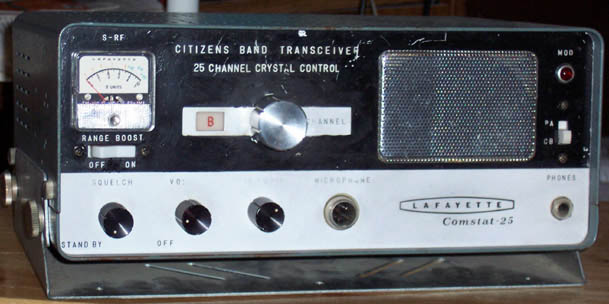

This is the Lafayette Comstat 25. This radio was manufactured in 1965, which was a few years before my entry into the CB hobby. Back in an earlier time in CB radio when vacuum tube AM-Only radios ruled the airwaves. This radio was one iteration of a number of similar radios offered by brands such as Teaberry, Gemtronics, Robyn, and others, which were made by Matsushita in Japan. The Comstat came equipped with typical standard features including Volume, Squelch, variable Fine Tuning, P.A., a large "S"/R.F. meter, modulation indicator, and a "Range Boost" (a modulation booster) switch. While primarily designed as a base station, it had the capability to run off of 12V for mobile operation.
This model radio was somewhat of a novelty as it had a true 25 channels installed (23 standard class "D" CB channels, plus an "A" and "B" channel). The Comstat 25 had the frequencies of 27.235 and 27.245 installed in the "A" and "B" positions, which were commonly referred to as channels "22A" and 22B" by CB hobbyists, and which would become Channels 24 and 25 in 1977 when the CB band expanded to 40 channels. I had originally assumed that these were part of the business band allocation which may have been legal to share within the same radio (if properly licensed). But after finding an original copy of the owner's manual, the true reason for those two "extra" channels was for a program, originated by a petition from the Automobile Manufacturer's Association, and pending approval by the FCC, called H.E.L.P. (Highway Emergency Locating Plan). I could not find the exact specifics on the plan, but presumably these frequencies were to be used for highway emergency traffic. At the time the radio was made, these channels were not yet legal to use, and the manual warns not use them until approval was granted (Talk about a much more trusting government back then). Evidently FCC approval for this program was never granted, as those channels disappeared from the subsequent Comstat 25A model, and the emergency channel eventually became Channel 9. The other unique novel feature on the Comstat 25 was a back panel switch, which dropped the power output to 100 mW. Allegedly (or so I've been told), back then as a selling point, it was claimed that you could legally operate your new radio, while you waited (what seemed like forever back then) for your license application to be processed by the FCC, by switching to the 100 mW position. Range would be much less of course, but at least you were on-the-air. But shortly afterward though, the rules for part's 15 and 95 were further clarified. So even with 100 mW of output power, it was now determined that you were not legal under Part 15 unless the antenna was self contained, and under 5 feet in length (basically the definition of a walkie-talkie). The reality of this caused the 100mW feature to be dropped as well from the subsequent "A" and "B" models of this radio. But it was these unique features that make this model a bit more desirable to the true collector.
This particular pictured radio was my original and also my very first base radio, which I obtained in the fall of 1974. Over 45 years later, and despite a few scratches, it still looks pretty good. During its years as my primary radio, it saw a fair (and by "fair", I mean a LOT) amount of use. I also added extra crystals to it in 1977 to enable operation on the new expanded 40 channels. This radio had fantastic adjacent channel rejection, or more accurately, immunity to front end overload or desense. I lived less than 1/4 mile away from no less than 6 other CBers, 2 of whom hung out on other channels. While they complained that I desensed them completely when I was on, I never heard them beyond 5 or 6 channels away. I guess those tube fronts ends really were much better at handling R.F. overload. The only "soft" spot that I found with this radio, was the transmit audio. It didn't have a particularly "punchy" sounding audio, and it was also a bit on the bassy side. The only mic that seemed to work well with it, was a D-104, who's high end frequency emphasis compensated somewhat for the radio's bassy sound. Since I never had another Comstat to compare to, I can't be sure if this was a common trait of all '25's, or a unique fault in my particular unit. Although after the Comstat was on bench last time, I discovered that the plate limiting resistor had been "strapped", resulting in a 6 watt carrier output. When that jumper was removed, and the carrier power returned to the usual 3.5 watts, the modulation cleaned up quite a bit and sounds far better.
Today, this radio proudly remains as part of my vintage collection. Since it was my original base, that makes its sentimental value all that much greater. It had developed a final oscillation problem, which turned out to have been caused by an open cap in the negative bias power supply. That has since been corrected (see this story for details), and the radio has been restored to operating condition. One of the crystals has quit, and another is far off-frequency, but despite those little issues, it still holds its own against more modern rigs.